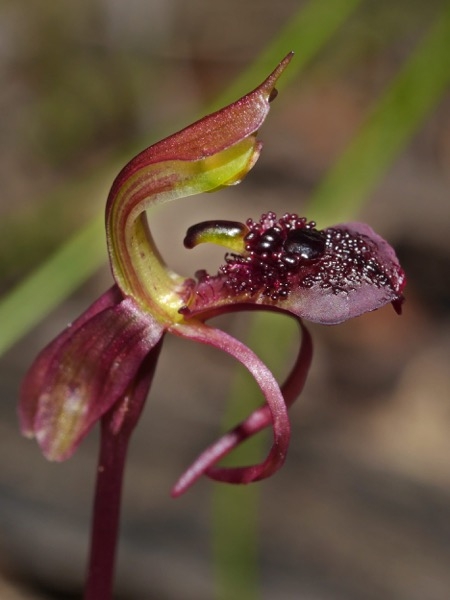This is the time of the year when we begin looking for our autumn species of terrestrial orchids and at the moment we are endeavouring to answer a question: do we have the Tall Bird Orchid, Chiloglottis trilabra, growing in the Anglesea district?
In 2004 we were excited to believe we had discovered this species growing out near Forest Road but now we are not so sure. The orchids we thought were C. trilabra were flowering in January that year, a factor that tended to make us believe that it was not the Autumn Bird Orchid, C. reflexa. We did at the time look at the distinguishing features between it and C. reflexa but we are now wondering did we look carefully enough and not just jump to conclusions. We know now that C. reflexa can flower in January in our area, as it was certainly doing this year.
We are therefore asking for your help to answer the question. If you find colonies of Chiloglottis leaves bearing flowers could you please look carefully at the flowers as the leaves are identical for both species (paired leaves growing in colonies.)

Different orchid books identify different features:
The labellum:
C. trilabra If you look at the labellum you will notice that it bears a mass of shiny black glands (calli). The calli occupy most of the upper surface and extend to the apex, the end of the labellum.

The labellum of C. reflexa also bears these shiny black calli but they tend to taper and stop before the apex.

In both species there is one large stalked callus at the top of the labellum. (This should be the easiest feature to identify!)
The stalked callus in C. reflexa projects well above the other calli. It also has a distinct notch in the tip.
However if you view the labellum of C. trilabra from the side you will notice that the large stalked callus is lower, and generally in line with the calli mass. It has a shallow notch at the tip.
The lateral sepals are also an indicator of the species – those of C. reflexa are usually strongly recurved beneath the labellum, while those of C. trilabra usually dangle downwards.
It is possible that C. trilabra could be widespread in the district – on the other hand it might just not grow here. We urge you to be on the alert as you walk the tracks and carry a hand lens with you.
Note: It is called trilabra as the specimen type of the species happened to be abnormal, having an extra labellum in place of each of the two petals. For some reason the species name was never changed.
Margaret MacDonald